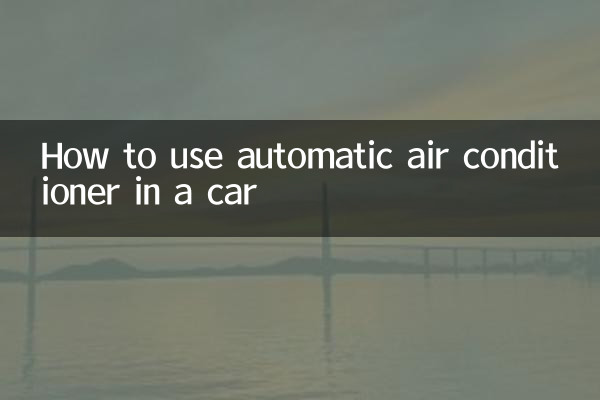How to use automatic air conditioner in a car
With the continuous development of automotive technology, automatic air conditioning has become the standard feature of most modern vehicles. However, many car owners are not familiar with the use of automatic air conditioners, and even mistakenly think that it is just "automatically adjusting the temperature". This article will combine popular topics and hot contents on the Internet for the past 10 days to analyze the correct usage of car automatic air conditioners for you in detail, and attach relevant data comparisons to help you better master this function.
1. The difference between automatic air conditioning and manual air conditioning

The biggest difference between automatic air conditioners and manual air conditioners is their intelligence. Automatic air conditioning monitors temperature, humidity and other parameters in real time through in-car sensors, and automatically adjusts the air volume, wind direction and temperature to maintain a constant and comfortable environment in the car. Manual air conditioning requires the driver to manually adjust these parameters.
| Comparison items | Automatic air conditioning | Manual air conditioner |
|---|---|---|
| Temperature regulation | Automatic constant temperature | Manual adjustment |
| Air volume control | Automatic adjustment | Manual adjustment |
| Comfort | Higher | Rely on driver operation |
| Energy consumption | Relatively low | Probably higher |
2. Basic operating steps of automatic air conditioning
1.Start automatic mode: Press the "AUTO" button and the air conditioning system will automatically adjust the air volume, temperature and wind direction. At this point, you just need to set the target temperature.
2.Set temperature: Set the temperature you want in the car through the temperature adjustment button or knob. Generally, it is recommended to set the temperature between 22-24°C for optimal comfort and energy consumption balance.
3.Adjust the wind direction: Although the automatic air conditioner will intelligently adjust the wind direction, you can also manually adjust the direction of the air outlet to meet personalized needs.
4.Use internal and external cycles: When the air quality is poor or needs to be cooled quickly, you can switch to the internal circulation mode; when driving for a long distance or ventilation is required, you can switch to the external circulation mode.
3. Advanced functions of automatic air conditioning
1.Zone temperature control: Some high-end models support partition temperature control function, allowing drivers and passengers to set different temperatures respectively.
2.Seat heating/ventilation linkage: The automatic air conditioners of some models can be linked to the seat heating or ventilation function to further improve comfort.
3.Remote preheating/pre-cooling: Through the mobile APP, some models support remote start of air conditioners and adjust the temperature inside the car in advance.
| Function | Applicable scenarios | Operation method |
|---|---|---|
| Zone temperature control | Multiple people ride, different temperature requirements | Adjustment via central control screen or independent temperature zone button |
| Seat linkage | Extreme temperatures in winter or summer | Automatically or manually turn on the seat heating/ventilation |
| Remote control | Adjust the temperature in the car in advance | Operation through mobile APP |
4. Things to note when using automatic air conditioning
1.Avoid too low temperature settings: In summer, it is not recommended to set the temperature too low (such as below 20℃) to avoid increasing energy consumption and physical discomfort.
2.Regularly replace air conditioner filter: The cleanliness of the air conditioner filter element directly affects the effect of the air conditioner and the air quality in the car. It is recommended to replace it every 10,000-20,000 kilometers.
3.Turn off the air conditioner before long stopping: Turn off the air conditioner in advance before parking (keep the fan running) to prevent mold from growing in the air conditioner system.
4.Use internal and external circulation reasonably: When congested road sections or poor air quality, it is recommended to use the internal circulation mode; when driving at high speed or when ventilation is required, switch to the external circulation mode.
5. Frequently Asked Questions
1.Why does the air volume of automatic air conditioners suddenly increase?: This is usually a normal reaction when the system detects that the temperature in the car is large and the set value is different. The air volume will automatically decrease after the temperature approaches the set value.
2.Does automatic air conditioning cost electricity?: Compared with manual air conditioners, automatic air conditioners usually consume less energy because they will intelligently adjust the operating status according to actual needs.
3.Can the automatic air conditioner be turned on all the time?: Yes, but it is recommended to turn off the air conditioner during long stops to protect the system and save energy.
Through the above content, I believe you have a more comprehensive understanding of how to use automatic air conditioners in your car. Correct use of automatic air conditioners can not only improve driving comfort, but also reduce energy consumption and extend the service life of the air conditioning system. If you have any other questions, please leave a message in the comment area to discuss!

check the details

check the details